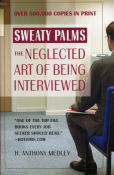| What REALLY goes on in a job interview? Find out in the new revision of "Sweaty Palms: The Neglected Art of Being Interviewed" (Warner Books) by Tony Medley, updated for the world of the Internet . Over 500,000 copies in print and the only book on the job interview written by an experienced interviewer, one who has conducted thousands of interviews. This is the truth, not the ivory tower speculations of those who write but have no actual experience. "One of the top five books every job seeker should read," says Hotjobs.com. | |
| Flyboys (10/10) by Tony Medley World War I is the war Hollywood forgot. But after “Wings” won the first Academy Award as Best Picture in 1929, followed by “Hell’s Angels” and “The Dawn Patrol” in 1930 (all three of which were directed by experienced pilots), and “All Quiet on the Western Front” which made a star of Lew Ayres, whose widow was a long time bridge partner of mine, WWI was basically discarded by Hollywood. Director Tony Bill, a pilot himself, has resurrected WWI and made one of the most entertaining war movies I’ve seen. With an intelligent script played by good actors, a sweet love story, and the best aerial dogfight sequences ever filmed, it expertly captures what it must have been like fighting WWI in the deadly air over France where a pilot’s life expectancy was 17 days. Bill and screenwriters Phil Sears and Blake T. Evans & David S. Ward tell the story of the Lafayette Escadrille, a group of Americans who enthusiastically took to the air to defend France in the days before America joined the war in 1917. The characters are composites of real people. Pilot Frank Luke, a Congressional Medal of Honor winner, was the model for Blaine Rawlings (James Franco), who is the protagonist of the film. Raoul Lufbery, who became a legend by his single-minded efforts to avenge the death of his best friend, was the inspiration for Reed Cassidy (Martin Henderson), who is the paterfamilias for the group of young Americans in the film. The other characters in the film are similarly based on real life people, even Skinner (Abdul Salis), whose character is based on Eugene Bullard, the first black military pilot. The incidents shown, too, are based on fact. Rawlings’ rescue of Eddie Beagle (David Ellison) is drawn from an incident described in Nordhoff & Hall’s “The Lafayette Flying Corps.” Rawlings falls in love with Lucienne (Jennifer Decker), a French girl who can’t speak English. Their evolving relationship, as neither speaks the other's language, is touchingly established by accomplished acting. A combination of real planes really flying and CGI was used to create the dogfights. The replicas of vintage aircraft were constructed “rib by rib” on the computer and modeled to exact dimensions. Careful rigging and controls were devised for all the aircraft which would replicate exactly how a real plane would function during various maneuvers. The movements of the real and model planes were then digitally captured and integrated into new animation. The result places the audience in the middle of aerial action that is breathtaking. One thing this film adds to the mix of WWI movies is the addition of tracer fire, which has never before been shown in a WWI film, despite the fact that one of the WWI diaries described the sky during a dogfight as “a spider web of tracer fire.” The dogfights alone are worth the price of admission. The only other film I’ve seen solely for the special effects was “Jurassic Park.” Those dinosaurs, which were spectacular, have nothing on the aerial special effects in this movie. But this film is not just dogfights. The story is interesting, especially when most of the incidents and people are fact-based; the actors are, without exception, top rate; and the girlfriend is sweet and beautiful. Sure, it’s schmaltzy. But this doesn’t pretend to be something it’s not. It’s a 124-minute old-fashioned, John Wayne-type, feel good war movie. And what’s wrong with that? I loved it. September 21, 2006
|
|
|
|
|
